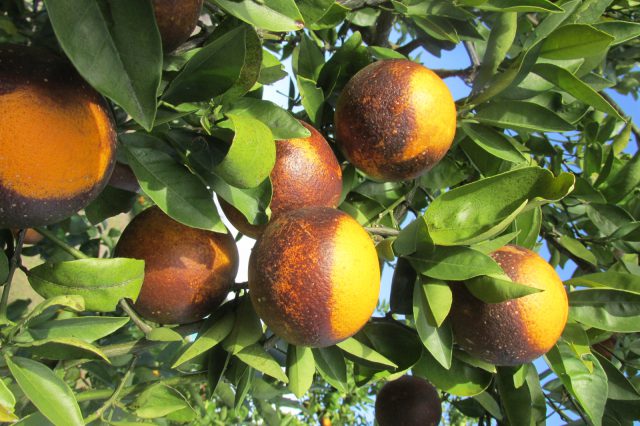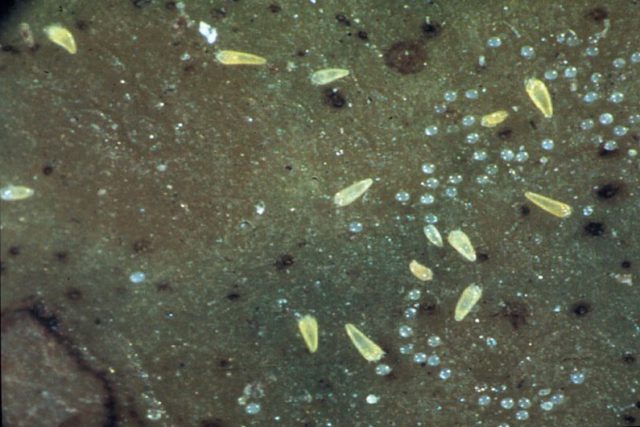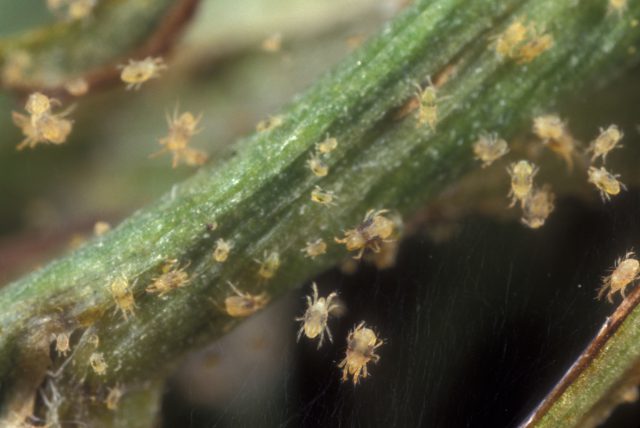Xavier Martini, Pete Andersen, UF/IFAS North Florida Research and Education Center
In May 2017, Asian citrus psyllids (Diaphorina citri) were found in the experimental citrus grove at the Suwannee Valley Extension Center in Live Oak. The trees were quickly treated with an insecticide containing the active ingredient, cyantraniliprole. This treatment was highly justified as the Asian citrus psyllid is the vector of Candidatus liberibacter asiaticus, the presumed causal agent of citrus greening. Citrus greening has devastated the citrus industry in south and central Florida, and this was the first time that Asian citrus psyllid were found in Suwannee County. Considering that citrus groves of satsuma have been planted in close proximity to this psyllid population, it was important and justified to apply insecticide.

Fig. 1: Citrus Russ mite damage (credit photo: Betsy Martin)
Then the story got even more interesting. A few days following the insecticide treatment of the citrus grove, rust mites started to build up very fast on the trees. The fruits exhibited the typical bronzing damage due to rust mites observed on mature trees (Fig. 1). Rust mites are microscopic elongated mites about 0.15 mm in length (Fig. 2). Severe damage (over 60% of the fruit surface) from rust mites could lead to fruit drop and size reduction; however, the damage is often only cosmetic. Therefore, most of the time rust mite control is typically only required if the fruits are designated for the fresh market

Fig. 2: Citrus Russ mites (Credit photo: Michael Roger)
An outbreak of mites often occurs on citrus after the application of pyrethroid insecticides. Citrus rust mites, as well as other mites found on citrus (such as spider mites), are usually well controlled by a complex of natural enemies, including predatory mites. However, these predatory mites are usually quite sensitive to insecticides, so the elimination of these predators allows for the drastic increase of the pest mite population. This is the likely explanation of what we observed in these particular groves.
Outbreaks of mites following insecticide treatments have been documented as early as 1956, following the broad adoption of insecticide use in modern agriculture. It was observed that spraying fruit trees or row crops such as cotton with organophosphate or pyrethroid insecticides was followed by an outbreak of secondary pests such as spider mites. In fact, spider mites were not considered a serious pest until the “green revolution” with the widespread use of insecticides causing the drastic reduction of their natural enemies. This phenomenon, called “secondary pest resurgence” is well known in many crops. For instance in peanut crops, resurgence of the two-spotted spider mite (Fig. 3) is induced by the application of foliar insecticides and fungicides to control primary pests. Excessive spraying of citrus could lead to the resurgence of other pests that are usually well controlled by natural enemies, including citrus whiteflies, mealybug, or scale insects.
This short story is a reminder that spraying an insecticide may not be a harmless action, as it usually kills more than just the target species. It is, therefore, very important to follow label recommendations, and to apply insecticides only when the economic threshold, indicated by the number of pests, is reached. Economic threshold values for citrus pests are available in the publications listed below. To accurately monitor these values, it is also advisable to scout your citrus grove for insect pests twice per week.
To minimize risk of secondary pest resurgence, use of biorational insecticides, that are less detrimental to natural enemies, are recommended. To re-balance the natural enemy’s population, predatory mites can be purchased from biocontrol companies, and can be released on the crops a few days after the insecticidal spray.

Fig. 3: Two-spotted spider mites (credit photo: Lyle Buss)
For more information on citrus rust mites and other mites in citrus, please see the following UF/IFAS Publications
-
2017-2018 Florida Citrus Production Guide
-
2017-2018 Florida Citrus Production Guide: Rust Mites, Spider Mites, and Other Phytophagous Mites
- Pepper Weevil is a True Menace to Pepper Production - October 3, 2025
- Sap Beetles are Not a Cause of Concern for Citrus but Katydids Are - October 4, 2024
- The Importance of Pollination for Seedless Watermelons and How to Enhance it - April 5, 2024
